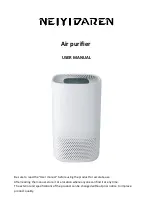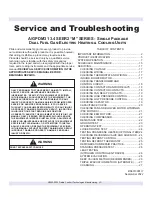
23
EN
Specifications are subject to change without notice.
© 2022 Mitsubishi Electric US, Inc.
Specifications are subject to change without notice.
© 2022 Mitsubishi Electric US, Inc.
-Power supply cords of appliances shall not be lighter than design 245 IEC 57, 227 IEC 57, 245 IEC 53 or 227 IEC 53.
-A switch with at least 3 mm contact separation in each pole shall be provided by the air conditioner installation.
Total operating current of
the Indoor unit
Minimum wire thickness (mm
2
)
Ground-fault interrupter *1
Local switch (A)
Breaker for wiring (A)
(Non-fuse breaker)
Main cable
Branch
Ground
Capacity
Fuse
F0 = 16 A or less *2
1.5
1.5
1.5
20 A current sensitivity *3
16
16
20
F0 = 25 A or less *2
2.5
2.5
2.5
30 A current sensitivity *3
25
25
30
F0 = 32 A or less *2
4.0
4.0
4.0
40 A current sensitivity *3
32
32
40
Apply to IEC61000-3-3 about Max. Permissive System Impedance.
*1 The Ground-fault interrupter should support Inverter circuit.
The Ground-fault interrupter should combine using of local switch or wiring breaker.
*2 Please take the larger of F1 or F2 as the value for F0.
F1 = Total operating maximum curent of the indoor units × 1.2
F2 = {V1 × (Quantity of Type1)/C} + {V1 × (Quantity of Type2)/C} + {V1 × (Quantity of Type3)/C} + {V1 × (Quantity of Others)/C}
Indoor unit
V1
V2
PVFY-NAMU
38
1.6
C : Multiple of tripping current at tripping time 0.01s
Please pick up “C” from the tripping characteristic of the breaker.
<Example of “F2” calculation>
*Condition PVFY-NAMU × 3, C = 8 (refer to right sample chart)
F2 = 38 × 3/8
= 14.25
16 A breaker (Tripping current = 8 × 16 A at 0.01s)
12
GB
D
F
E
I
NL
P
GR
RU
TR
CZ
SV
HG
PO
5. Never connect the power cable to leads for the transmission cables. Otherwise
the cables would be broken.
6. Be sure to connect control cables to the indoor unit, remote controller, and the
outdoor unit.
7. Put the unit to the ground on the outdoor unit side.
8. Select control cables from the conditions given in page
12
.
9. Perform wiring in compliance with the safety regulations detailed in UL1995.
Caution:
• Be sure to put the unit to the ground on the outdoor unit side. Do not
connect the earth cable to any gas pipe, water pipe, lightening rod, or
telephone earth cable. Incomplete grounding may cause a risk of electric
shock.
• If the supply cord is damaged, it must be replaced by the manufacturer, its
service agent or similarly qualified persons in order to avoid a hazard.
Precautions on electrical wiring
Warning:
Electrical work should be done by qualified electrical engineers in accord
-
ance with “Engineering Standards For Electrical Installation” and supplied
installation manuals. Special circuits should also be used. If the power circuit
lacks capacity or has an installation failure, it may cause a risk of electric
shock or fire.
1. Be sure to install an earth leakage breaker to the power.
2. Install the unit to prevent that any of the control circuit cables (remote controller,
transmission cables) is brought in direct contact with the power cable outside
the unit.
3. Ensure that there is no slack on all wire connections.
4. Some cables (power, remote controller, transmission cables) above the ceiling
may be bitten by mouses. Use as many metal pipes as possible to insert the
cables into them for protection.
9. Electrical wiring
Transmission cable specifications
Transmission cables
ME Remote controller cables
MA Remote controller cables
Type of cable
Shielding wire (2-core)
CVVS, CPEVS or MVVS
Sheathed 2-core cable (CVV,
shielded CVVS, CPEVS or MVVS)
Sheathed 2-core cable
Cable diameter
More than 1.25 mm
2
0.3 ~ 1.25 mm
2
(0.75 ~ 1.25 mm
2
)*1
0.3 ~ 1.25 mm
2
(0.75 ~ 1.25 mm
2
)*1
Remarks
Max length: 200 m
Maximum length of transmission lines for centralized control and indoor/
outdoor transmission lines (Maximum length via indoor units): 500 m MAX
The maximum length of the wiring between power supply unit for
transmission lines (on the transmission lines for centralized control) and
each outdoor unit and system controller is 200 m.
When 10 m is exceeded, use
cables with the same specification
as transmission cables.
Max length: 200 m
*1 Connected with simple remote controller.
CVVS, MVVS: PVC insulated PVC jacketed shielded control cable
CPEVS: PE insulated PVC jacketed shielded communication cable
CVV: PVC insulated PVC sheathed control cable
9.1. Power supply wiring
• Power supply cords of appliances shall not be lighter than design 245 IEC 57, 227 IEC 57, 245 IEC 53 or 227 IEC 53.
• A switch with at least 3 mm contact separation in each pole shall be provided by the Air conditioner installation.
[Fig. 9.1.1] (P.5)
A
Ground-fault interrupter
B
Local switch/Wiring breaker
C
Indoor unit
D
Pull box
Total operating current of
the Indoor unit
Minimum wire thickness (mm
2
)
Ground-fault interrupter *
1
Local switch (A)
Breaker for wiring (A)
(Non-fuse breaker)
Main cable
Branch
Ground
Capacity
Fuse
F0 = 16 A or less *
2
1.5
1.5
1.5
20 A current sensitivity *
3
16
16
20
F0 = 25 A or less *
2
2.5
2.5
2.5
30 A current sensitivity *
3
25
25
30
F0 = 32 A or less *
2
4.0
4.0
4.0
40 A current sensitivity *
3
32
32
40
Apply to IEC61000-3-3 about Max. Permissive System Impedance.
*1 The Ground-fault interrupter should support Inverter circuit.
The Ground-fault interrupter should combine using of local switch or wiring breaker.
*2 Please take the larger of F1 or F2 as the value for F0.
F1 = Total operating maximum curent of the indoor units × 1.2
F2 = {V1 × (Quantity of Type1)/C} + {V1 × (Quantity of Type2)/C} + {V1 × (Quantity of Type3)/C} + {V1 × (Quantity of Others)/C}
Indoor unit
V1
V2
PEFY-NMAU
38
1.6
C : Multiple of tripping current at tripping time 0.01s
Please pick up “C” from the tripping characteristic of the breaker.
<Example of “F2” calculation>
*Condition PEFY-NMAU × 3, C = 8 (refer to right sample chart)
F2 = 38 × 3/8
= 14.25
➞
16 A breaker (Tripping current = 8 × 16 A at 0.01s)
20
C
10
8
6
4
3
2
1
0.01
0.1
1
10
60
600
6000
SAMPLE
Tr
ip
pi
ng
Ti
me
[s
]
Rated Tripping current (x)
Sample chart
13
GB
D
F
E
I
NL
P
GR
RU
TR
CZ
SV
HG
PO
9.3. Connecting electrical connections
Please identify the model name of the operation manual attached on the terminal
box cover with that shown on the rating name plate.
1. Remove the screw (1pc) holding the cover to dismount the cover.
[Fig. 9.3.1] (P.6)
A
Screw holding cover (1pc)
B
Cover
2. Open knockout holes
(Recommend to use a screwdriver or the like for this work.)
[Fig. 9.3.2] (P.6)
C
Terminal box
D
Knockout hole
E
Remove
3. Fix power source wiring to terminal box by using buffer bushing for tensile
force. (PG connection or the like.) Connect transmission wiring to transmis-
sion terminal block through the knockout hole of terminal box using ordinary
bushing.
[Fig. 9.3.3] (P.6)
F
Use PG bushing to keep the weight of the cable and external force from being
applied to the power supply terminal connector. Use a cable tie to secure the
cable.
G
Power source wiring
H
Use ordinary bushing
I
Transmission wiring
J
Conduit
K
Side frame
L
Knockout hole (for power source wiring)
M
Washer (round) (accessory)
4. Connect the power source, Earth, transmission and remote controller wiring.
The dismounting of the terminal box is not needed.
[Fig. 9.3.4] (P.6)
N
Terminal block for power source
O
Terminal block for indoor transmission
P
Terminal block for remote controller
[Shield wire connection]
[Fig. 9.3.5] (P.6)
A
Terminal block
B
Round terminal
C
Shield wire
D
The earth wire from two cables are connected together to the S terminal. (Dead-
end connection)
E
Insulation tape (To keep the earth wire of the shielded cable from coming in contact
with the transmission terminal)
5. After wiring is complete, make sure again that there is no slack on the con-
nections, and attach the cover onto the terminal box in the reverse order of
removal.
Notes:
• Do not pinch the cables or wires when attaching the terminal box cover.
Doing so may cause a risk of disconnection.
• When accommodating the terminal box, make sure that the connectors on
the box side are not removed. If removed, it cannot operate normally.
9.4. External I/O specifications
Caution:
1. Wiring should be covered by insulation tube with supplementary insula-
tion.
2. Use relays or switches with IEC or equivalent standard.
3. The electric strength between accessible parts and control circuit should
have 2750 V or more.
9.2. Connecting remote controller, indoor
and outdoor transmission cables
• Connect indoor unit TB5 and outdoor unit TB3. (Non-polarized 2-wire)
The “S” on indoor unit TB5 is a shielding wire connection. For specifications
about the connecting cables, refer to the outdoor unit installation manual.
• Install a remote controller following the manual supplied with the remote control
-
ler.
• Connect the “1” and “2” on indoor unit TB15 to a MA remote controller. (Non-
polarized 2-wire)
• Connect the “M1” and “M2” on indoor unit TB5 to a M-NET remote controller.
(Non-polarized 2-wire)
• Connect the remote controller’s transmission cable within 10 m [32 ft] using a
0.75 mm
2
[AWG18] core cable. If the distance is more than 10 m [32 ft], use a
1.25 mm
2
[AWG16] junction cable.
[Fig. 9.2.1]
(P.5) MA Remote controller
[Fig. 9.2.2]
(P.5) M-NET Remote controller
A
Terminal block for indoor transmission cable
B
Terminal block for outdoor transmission cable
C
Remote controller
• DC 9 to 13 V between 1 and 2 (MA remote controller)
• DC 24 to 30 V between M1 and M2 (M-NET remote controller)
[Fig. 9.2.3]
(P.6) MA Remote controller
[Fig. 9.2.4]
(P.6) M-NET Remote controller
A
Non-polarized
B
TB15
C
Remote Controller
D
TB5
• The MA remote controller and the M-NET remote controller cannot be used at
the same time or interchangeably.
Caution:
Install wiring so that it is not tight and under tension. Wiring under tension
may break, or overheat and burn.
*3 Current sensitivity is calculated using the following formula.
G1 = (V2 × Quantity of Type1) + (V2 × Quantity of Type2) + (V2 × Quantity of Type3) + (V2 × Quantity of Others) + (V3 × Wire length [km])
G1
Current sensitivity
Wire thickness
V3
30 or less
30 mA 0.1 sec or less
1.5 mm
2
48
100 or less 100 mA 0.1 sec or less
2.5 mm
2
56
4.0 mm
2
66
Caution:
Do not use anything other than the correct capacity breaker and fuse. Using fuse, wire or copper wire with too large capacity may cause a risk of malfunction
or fire.
9. Electrical wiring
















































